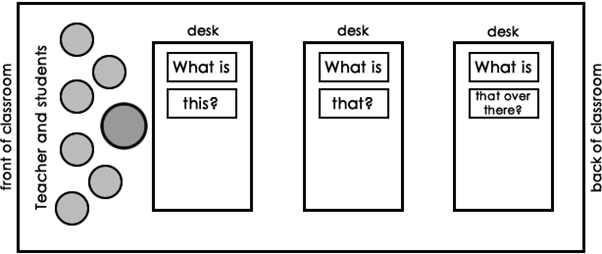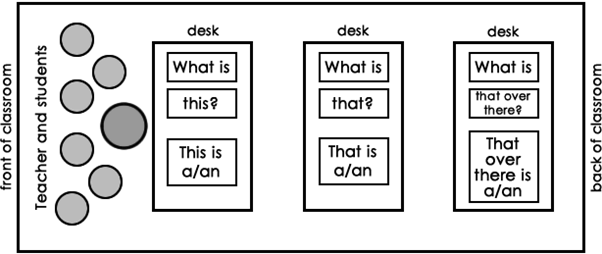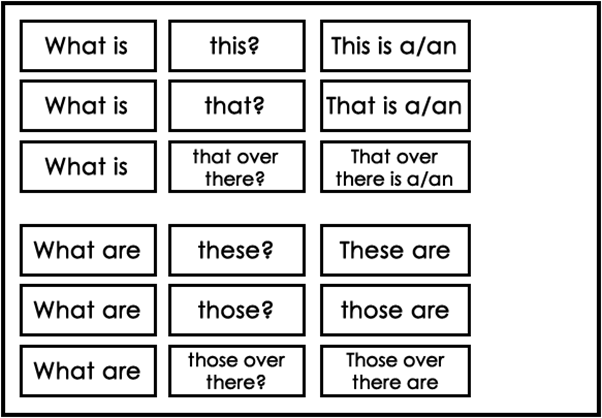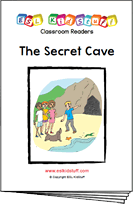Menu
Download the accompanying materials to this lesson plan - sign up here
Resources and materials for ESL Kids teachers
Demonstrative pronouns are words that point to specific things. For example, “This is a pen”.
These pronouns show the relationship between the person speaking and the object:
Demonstrative pronouns differ in singular and plural forms:
Your students will have heard you use demonstrative pronouns in every lesson as part of your classroom discourse (e.g. “What is this?”, “Can you pass me that ball?”, etc.). In this lesson, students can practice using these pronouns correctly to point specific things out.
See our "Warm Up & Wrap Up" page.
1. Introduce the demonstrative pronouns
We’ll need to be well organized when presenting the different demonstrative pronouns to your class – you want to make sure the structures are clearly explained and easy to understand for your students. If this section of the lesson goes well the other parts will follow easily and you’ll have a lot of fun.
Before class, cut out the “Demonstrative pronouns structures cards”. Also prepare 9 objects – I use 9 plastic animals to make it fun, but anything will do, e.g. 9 pens, 9 fruit, 9 toy vehicles, etc.
Start the lesson by standing at the front of the class. Tell everyone to stand up and come up to the front of the class, standing behind you. This will result in a bit of mayhem. Make sure you make enough space between you and the wall for everyone to fit comfortably in.
STAGE 1
You will now have any empty classroom of desks and chairs in front of you. Take out one of your objects (I’ll use plastic animals - in this case a toy cat) and place it on the desk in front of you. Point to it and ask the class “What?” and elicit “A cat”.
Next place a cow on a table in the middle of the classroom and again elicit what it is simply by saying “What?” and pointing.
Finally, place an elephant on the table at the far end of the classroom and elicit what it is.
Now, take out the 3 “What is” cards from your demonstrative pronouns card set and put each one next to each of the 3 animals. Then go back to the front of the class and show the three cards for “this?”, “that?”, “that over there?”. Give each card to a student and ask them to place the cards where they think they belong to complete the questions. You can give help if necessary, but I usually find that some students in the class will be able to direct the students correctly.
By this point you should have the cards laid out in the classroom as follows:

Next take out the “This is a/an”, “That is a/an” and “That over there is a/an” cards and ask three different students to place them next to the questions on the desks. You should end up as follows:

Now test students by asking questions and pointing, such as:
Teacher: Miki, what is that? (pointing at the cow)
Student: That is a cow.
Teacher: Good! Freddy, what is this? (pointing at the cat)
Student: This is a cat.
etc.
Put students in pairs and give them a couple of minutes asking and answering the questions for the animals on the desks.
STAGE 2
Now we’ll introduce plurals. Take out two of the same animal (e.g. two dogs) and place them on the nearest table. Elicit the animals (“What?”, “Dogs.”). Then do the same for the other two desks (e.g. 2 horses and 2 monkeys) until you have two pairs of animals on each desk.
Take out the three “What are” cards and also the cards “these?”, “those?” and “those over there”. Ask three students to place the cards on the correct tables.
Finally, ask three more students to place the “These are”, “Those are” and “Those over there are” cards on the correct desks.
End by modeling some conversations, for example:
Teacher: Andre, what is this? (pointing at the cat)
Student: This is a cat.
Teacher: Good job! Sara, what are those over there? (pointing at the 2 monkeys)
Student: Those over there are monkeys.
etc.
Then put students into pairs to practice asking and answering the questions.
2. Arrange the board with structures
Give students some tape and ask them to stock the demonstrative pronoun cards onto the board in a logical way, for example:

Then in the space to the right of each sentence ask different students to draw the animals that were used (e.g. a cat next to “This is a/an”, a cow next to “That is a/an”, etc.).
3. Play “All around the classroom”
Sit students back down at their desks and put in pairs. Pairs take it in turns to ask questions and point to things around the classroom, such as:
Student A: What is that over there?
Student B: That is a book.
Student A: No, next to the book.
Student B: Um, that is a pencil case.
Students A: Yes, that’s right!
As the students are speaking, circulate around the class and help out with vocabulary and structures.
Let the activity run for around 5-10 minutes. Then do a class check by asking different pairs to stand up and show the class one of their conversations.
4. Play the “this, that, these, those board game”
Before class, print out enough board games for each group for 2-4 students (if possible, blow it up to A3 size). Each group will need one dice and a counter per student. Place students in groups of 2-4 around a table and give out the board games. As a class, read through the instructions and make sure everyone is clear of how to play.
As everyone plays the game, circulate around the class checking for correct usage.
5. Do the “this, that, these, those 1” worksheet
Give out the worksheet and have everyone fill in the blanks. Then check answers as a class.
6. Read classroom reader "The Secret Cave"
TBefore class, download and print off the reader "The Secret Cave". As you go through each page, indicate what the kids in the story are pointing at and ask your students which demonstrative pronoun should be used and also what it is they are actually pointing at, for example:
 Teacher: (reading from page 3 and 4) "Suddenly, Sue noticed something. “What’s …?” (pause as you wait for someone to say the missing word).
Teacher: (reading from page 3 and 4) "Suddenly, Sue noticed something. “What’s …?” (pause as you wait for someone to say the missing word).
Student: “… this?”
Teacher: Yes, that’s right! (reading) ... "What’s this?, she asked". What do you think it is?
Student: A tail!
Teacher: Let’s check … (reading) … “It looks a bit like a tail”. Yes, well done!
Continue through the story, getting everyone to say the pronouns and guess what the things in the cave are.
After reading the story, give out a reader worksheet to each student and have pairs or small groups fill in the answers. Finally, quickly read through the story again to check the answers.
---
Alternatively, watch our video version of the reader (Internet connection required):
7. Play “Run and touch the object”
Let’s finish with a fun, high-energy game. Get everyone to stand up. The teacher says things that are in the classroom using the demonstrative pronouns and students must run and touch those objects. So, for example, if the teacher says “These are pencils” students must touch the pencils nearest the teacher, as it is all in relation to the location of the teacher. Other ideas:
1. Assign Homework: "this, that, these, those 2" worksheet.
2. Wrap up the lesson with some ideas from our "Warm Up & Wrap Up" page.
 Found a mistake?
Found a mistake?
Please let us know
Full access to all resources on ESL KidStuff including lesson plans, flashcards, worksheets, craft sheets,
song downloads, classroom readers, flashcards app and songs app.